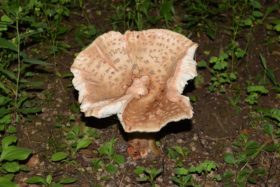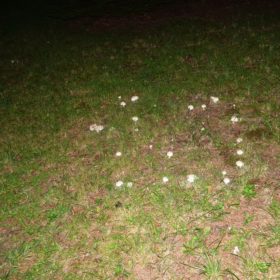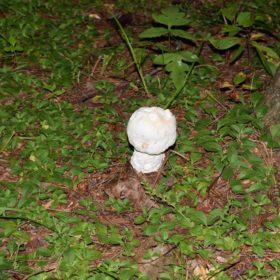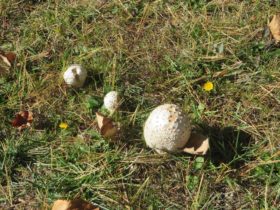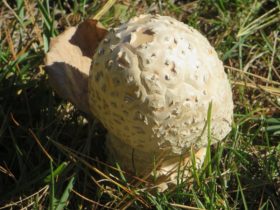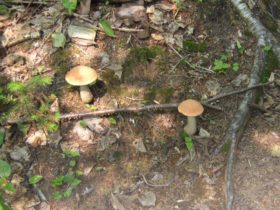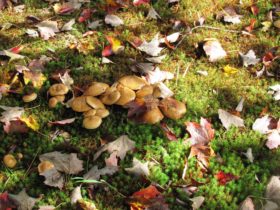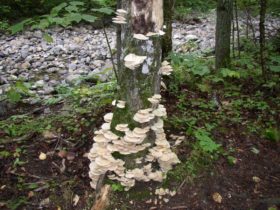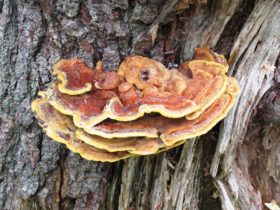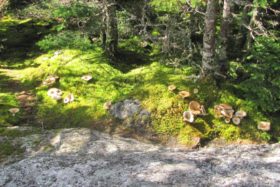Mushrooms and Fungi
Mushrooms are fungi (plural of fungus), but not all fungi are mushrooms. There are about 99,000 fungi species, including yeasts, mildews, molds, and mushrooms. Some mushrooms a poisonous! Do not eat wild mushrooms unless you are certain they are safe. None of the mushrooms noted or referenced here have been vetted for safety by the Encyclopedia.
The identification of these images have been taken from apparently reliable sources (noted below). Some might be prefaced by “apparently” or “unidentified” if identity is in doubt. All photos were taken in Maine.
Mushrooms
Oyster Mushroom?
This mushroom was found at the edge of a wooded driveway in Harpswell. Oyster would be appropriate for this coastal community! It looks like other images that were labeled “oyster mushrooms.” It is still “unidentified.”
Anyone have a reliable source?
Fairy Ring Mushrooms
The mushrooms are making the circle at outer edge of a fungus system that is mostly underground. The underground part, mycelium, is a network of strands that grow outward in a circle as they gobble up nutrients. When enough nutrients have been absorbed, the fruiting bodies (mushrooms) spring up at the edge of the mycelium to produce spores and propagate the fungus.
The name comes from a medieval belief that the circle was left by fairies who danced in a ring and then rested on the ”toadstools.”
Puffballs
The name is attached to several species of mushrooms of various sizes. The common name is a result of their appearance. Some are large and roughly rounded with a smooth white exterior. Some species are small, golf-ball sized. Those below are among the smaller species.
Unidentified Mushrooms
Mahoosuc ArmTrailRileyTWP (2003)
Shelf Fungi
These fungi make shelves or brackets to produce spores above the ground. The shelf fungi are a major wood rotting pest. Once infected, the fungus cannot be killed, causing millions of dollars in damage. The infected trees provide nesting sites for birds and squirrels since the rotten wood is easy to excavate. The tree stem often breaks as a result even though the tree is still alive and has leaves.
Shelf mushrooms on the Howe Brook Trail in Baxter State Park (2007)
Tree Lichen
Lichen is a life form made of a fungus and usually a green alga and/or a bacterium. Since the fungus cannot produce its own food, it is dependent on another life form. Green algae and cyanobacteria have chlorophyll that is essential for photosynthesis to make food.
When surrounded by the fungus, they provide the food to enable the lichen to exist.
Lichens produce their own food using sunlight energy and do not feed on the tree bark. The lichen bodies are attached to the outer tree bark and remain on the surface. They cause no harm to the trees they inhabit.
Rock Lichen
Lichens need clean, fresh air to survive. From beneficial nutrients to harmful toxins, lichens absorb it all. They also absorb water in the air, which is why so many are found in fog belts along oceans and big lakes. Lichens need nutrients to survive and grow. The main nutrients include nitrogen, carbon, and oxygen. Having lichens on your rocks, trees and ground around your property is a good thing. It means the air you breathe in is healthy and clean.
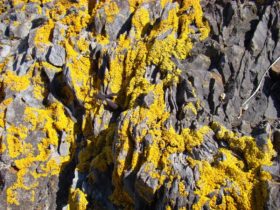
Lichen on rocks at a beach on Calderwood Island near the eastern end of the Fox Islands Thoroughfare in North Haven (2008)

Lichen on rocks at a beach on Calderwood Island near the eastern end of the Fox Islands Thoroughfare in North Haven (2008)
Additional resources
Alexopoulos, Constantine John; David Moore and Vernon Ahmadjian. “Fungus.” https://www.britannica.com/science/fungus (accessed August 9, 2018)
Daniel, George H. Rutgers University. New Jersey Agricultural Experiment Station. “Tree-Dwelling Lichens.” March 2013.
Department of Biology. Utah State University. “Shelf Fungi.” https://herbarium.usu.edu/fun-with-fungi/shelf-fungi (accessed August 31, 2018)
Ray, C. Claiborne. “Q & A Mushroom Rings.” NewYorkTimes.
https://www.nytimes.com/2002/10/29/science/q-a-mushroom-rings.html (accessed August 9, 2018)
United States. Department of Agriculture. Forest Service. “Lichen Habitat.” https://www.fs.fed.us/wildflowers/beauty/lichens/habitat.shtml (accessed August 31, 2018)
Another View, via e-mail by “Zander”, demonstrating the importance of careful use of mushrooms. Received 10/25/2021. No source references. Thanks for critique on labels.
Hi, I was researching mushrooms in the area, and stumbled across this page. I immediately noticed an amanita mislabeled as an oyster mushroom, which is a potentially deadly misidentification. It is clarified in the text as being just similar to other pictures of oysters, but frankly that’s not what any oyster mushrooms I’ve encountered, heard/read about, or seen online look like. Oyster mushrooms grow directly out of wood, rarely emerging from soil (still connected to buried wood when they do). Oyster mushrooms typically grow in groups, whereas amanitas are generally single or loosely scattered over an area. And most telling of all, it has patches! A key identifying feature of many amanitas, but not oysters. The picture is in my opinion more likely of an old A. Rubescens, A. Flavorubens, or A.Velatipes. Not all of which are necessarily deadly, but none are safe for inexperienced foragers.
Further down the page, there is another potentially deadly misidentification, where amanitas emerging from their egg stage are labeled as edible puffball mushrooms. This is abundantly obvious, again, due to the presence of patches. Puffballs might have small studs, and some species can develop mock veins, while others do develop scales at large sizes, but the mushrooms pictured are small and one picture clearly shows the remaining egg under the mushroom cap.
I also noticed what seem to be real oyster mushrooms labeled as “shelf mushrooms”, which would be a misnomer.
There is a disclaimer at the top of the page that “none of the mushrooms have been vetted for safety”, but these misidentifications seem to dangerous to ignore. I suggest relabeling the pictures as “Amanita Sp.”, or simply “Unknown” to avoid potential poisonings of overly trusting site visitors. The disclaimer honestly isn’t enough when the pictures are directly labeled as something they are not.
Full link: https://maineanencyclopedia.com/mushrooms-and-other-fungi/


